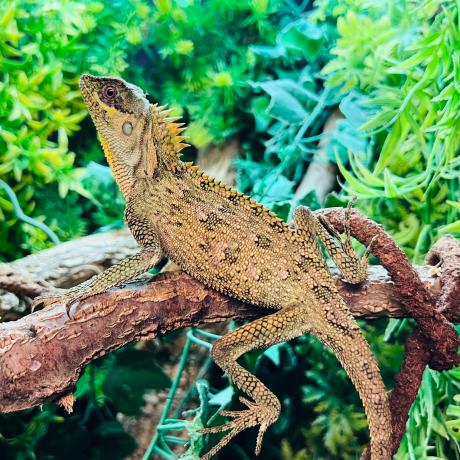

Also, known as forest dragons or pricklenape lizards. These arboreal reptiles spend much of their time off the ground on tree trunks or sat on branches.
| Origin | Southeast Asia |
|---|---|
| Environment | High elevation with dense vegetation |
| Adult Size | Up to 30cm |
| Suitability | Novice |
| Lifespan | Up to 10 years |
| Temperament | Moderate |
A medium sized lizard, with adults reaching a size around 30cm (12") snout to vent. They have a row of spines starting from behind the head which run along their spine.
Predominantly Acanthosaura sp. have a green to olive brown base colouration, but A. lepidogaster are known to get much brighter and contrasting colours of black, green, yellow and even white.
Males are known to be the larger of the two sexes, and develop a short spine over each eye and often have brighter colouration.
In the wild these lizards are found in areas of high elevation with dense vegetation. They have a wide distribution throughout southeast Asia, including countries such as; Cambodia Laos, Myanmar, Thailand and Vietnam.
Being arboreal lizards (tree dwelling), enclosures provided should be vertical rather than horizontal, and with a minimum height of 3-4ft. We’d advise keeping these lizards in the largest possible aluminium screen enclosures, but don’t overcrowd them.
Temperatures should be maintained around 24°C (75°F) during the day, and with a small night-time temperature drop. As always, temperatures are best controlled with a quality thermostat to prevent overheating.
Provide a 5% UVB fluorescent lamp over the top of the enclosure by using a canopy hood or alternately an appropriate wattage mercury vapour bulb providing both heat and light.
Maintain a humidity level of 70-80% by spraying the enclosure thoroughly with tepid water, including décor, substrate and at least twice a day. Often you will see these lizards actively drinking from cage décor as you spray their enclosure. To avoid animals dehydrating, it’s important to recognise they don’t often drink from still water. Despite this, it’s still advisable to provide a large water bowl for occasional bathing and drinking. Foggers will also help maintain humidity with Acanthosaura sp.
For cage décor, provide cork oak branches or similar, combined with vines and live or artificial plants. Ensure you fill out the enclosure well, to provide plenty of coverage and so that your dragon feels secure. Use bark chips, cypress mulch or a soil based substrate to cover the floor of the enclosure. Add sphagnum moss for decoration and to help raise the humidity if you wish.
Juveniles should be fed daily on a varying and suitably sized diet including; crickets, locusts, mealworms and waxworms. Adults can be fed three to four times a week.
Lastly and most importantly you must use a good quality dusting powder to provide essential calcium and vitamins to your mountain horned dragon. The traditional method of application is to use a spare live food tub or empty cereal container to coat the insects lightly in whichever dusting powder you are providing. We’d advise dusting your insects on every feed when your dragon is growing but to alternate between calcium and vitamin powders with the ratio of (2.1).